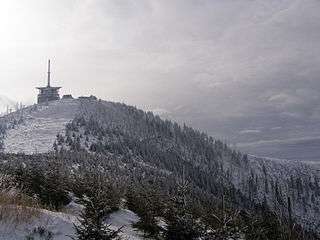Lysá hora
| Lysá hora | |
|---|---|
|
| |
| Highest point | |
| Elevation | 1,323 m (4,341 ft) |
| Prominence | 768 m (2,520 ft) |
| Isolation | 54 km (34 mi) |
| Coordinates | 49°32′45″N 18°26′51″E / 49.54583°N 18.44750°ECoordinates: 49°32′45″N 18°26′51″E / 49.54583°N 18.44750°E |
| Naming | |
| Etymology | Czech for bald mountain |
| Geography | |
 Lysá hora Location in the Czech Republic | |
| Location | Frýdlant nad Ostravicí, Moravian-Silesian Region, Czech Republic |
| Parent range | Moravian-Silesian Beskids |
| Geology | |
| Mountain type | Godulian Sandstone |
| Climbing | |
| Easiest route | paved road |
Lysá hora (Czech pronunciation: [ˈlɪsaː ˈɦora]; Polish: Łysa Góra; German: Lysa-berg, Kahlberg, local Silesian: Gigula) is the highest mountain of the Moravian-Silesian Beskids range in the Czech Republic and also of Cieszyn Silesia. It is one of the rainiest places of the country with an annual precipitation of over 1,500 mm (60 in).
Etymology
The name Lysá hora can be translated as bald mountain. This name came from the fact that Lysá hora had no trees. The place is first mentioned in a written document from 1261 as Lissa huera.
Tourism
Today, the mountain is also a small ski resort and a popular place for hiking in summer.
Nowadays, this summit is getting popular. Every day there are hundreds to thousands of causual hikers and funs of Nordic-walking, running, cross-country skiing and skialpinismus.
This place is a witness of many interesting sport contest, noteworthy is "Lysá Hora 24" (LH24), (LH365), "Beskydian Seven" (B7), Adrenalin Cup, "Five of Beskydian Summits"(5BV) and "Lysá Cup" (LC).
- In summer
- Sunset
 In winter
In winter
External links
-
 Media related to Lysá hora at Wikimedia Commons
Media related to Lysá hora at Wikimedia Commons - (Czech) Lysá Hora Mountain Center
- (Czech) Lysá Hora website
- (Czech) Lysá Hora webcam
- (Czech) Magnet zážitků v Beskydech: Lysá hora website